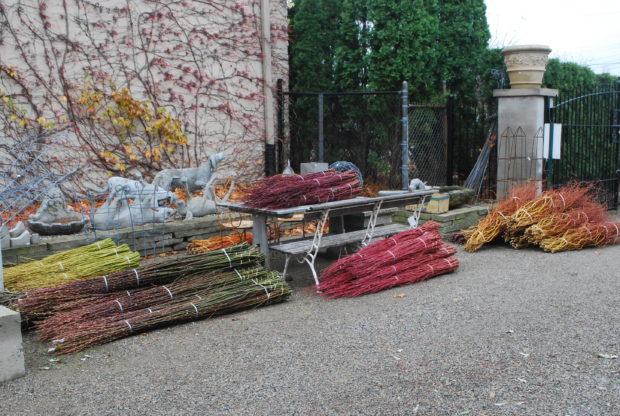 I have said many times over the course of the 7 years that I have been writing this blog – no northern zone gardener needs to close up shop with the first really hard frost. We can appreciate the season, we can be inventive, and we can defend ourselves against the long dark time. A thoughtfully planned landscape features trees with interesting bark, structure and fruit that warm the winter view. The skeletal remains of shrubs and perennials provide visual interest. Evergreens in the landscape are ever appreciated over the winter. A successful landscape is as beautiful in the winter as it is in the other three seasons. Designing a landscape that is consistently lively year long has been a life’s work for me. Any winter garden can be stunning. Many gardeners have made an effort to create a dialogue with their landscape that goes on day after day, all year round. Seasonally planted containers are a personal and engaging way to keep the story of the garden alive. Beautiful winter arrangements in pots can make the most quiet winter landscape glow with color, texture, mass, and light. The energy expended creating arrangements for winter pots results in a surplus of electricity sure to light the winter months. The most simple and easy to achieve celebration of the winter garden is container design and installation. It can be different every year. It can be as elaborate as you wish, or as simple as the meeting of lots of twigs and lots of lights. I recently posted on the importance of including lighting in those winter containers. Choosing the most effective means to light a pot of course depends on what you plan to put in them. We start with the branches. We have a grower who grows shrubs solely for their cut branches. His cut willow and dogwood branches are strikingly beautiful. That first fresh cut branch delivery day is a good day for all of us. The colors are brilliant. The lengths are generous. Once we cut the ties, each branch bunch branches out.
I have said many times over the course of the 7 years that I have been writing this blog – no northern zone gardener needs to close up shop with the first really hard frost. We can appreciate the season, we can be inventive, and we can defend ourselves against the long dark time. A thoughtfully planned landscape features trees with interesting bark, structure and fruit that warm the winter view. The skeletal remains of shrubs and perennials provide visual interest. Evergreens in the landscape are ever appreciated over the winter. A successful landscape is as beautiful in the winter as it is in the other three seasons. Designing a landscape that is consistently lively year long has been a life’s work for me. Any winter garden can be stunning. Many gardeners have made an effort to create a dialogue with their landscape that goes on day after day, all year round. Seasonally planted containers are a personal and engaging way to keep the story of the garden alive. Beautiful winter arrangements in pots can make the most quiet winter landscape glow with color, texture, mass, and light. The energy expended creating arrangements for winter pots results in a surplus of electricity sure to light the winter months. The most simple and easy to achieve celebration of the winter garden is container design and installation. It can be different every year. It can be as elaborate as you wish, or as simple as the meeting of lots of twigs and lots of lights. I recently posted on the importance of including lighting in those winter containers. Choosing the most effective means to light a pot of course depends on what you plan to put in them. We start with the branches. We have a grower who grows shrubs solely for their cut branches. His cut willow and dogwood branches are strikingly beautiful. That first fresh cut branch delivery day is a good day for all of us. The colors are brilliant. The lengths are generous. Once we cut the ties, each branch bunch branches out.
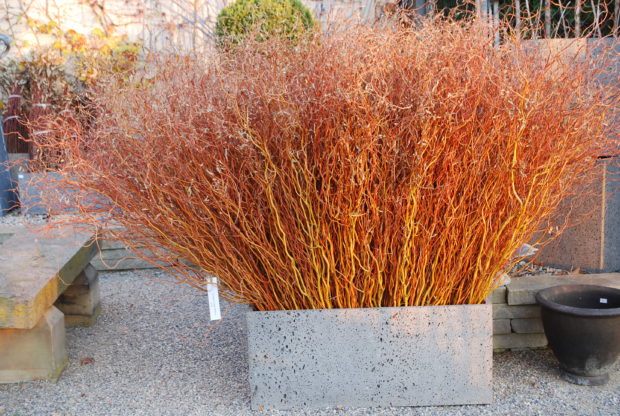 The curly copper willow may start out as a thick stem at the base, but at the top, the multiple curly branches delight my eye with their cinnamon color and exuberant mass. These dancing cut stems set into a winter container arrangement will endow any gardener’s winter with color, texture, rhythm – and vitality. Many of the fresh cut branches we set into winter containers go on to root, and grow on and out in the spring. I cannot really explain the intense pleasure I derive from this, except to say though the life of the garden cycles through the seasons, it is always alive in some form.
The curly copper willow may start out as a thick stem at the base, but at the top, the multiple curly branches delight my eye with their cinnamon color and exuberant mass. These dancing cut stems set into a winter container arrangement will endow any gardener’s winter with color, texture, rhythm – and vitality. Many of the fresh cut branches we set into winter containers go on to root, and grow on and out in the spring. I cannot really explain the intense pleasure I derive from this, except to say though the life of the garden cycles through the seasons, it is always alive in some form.
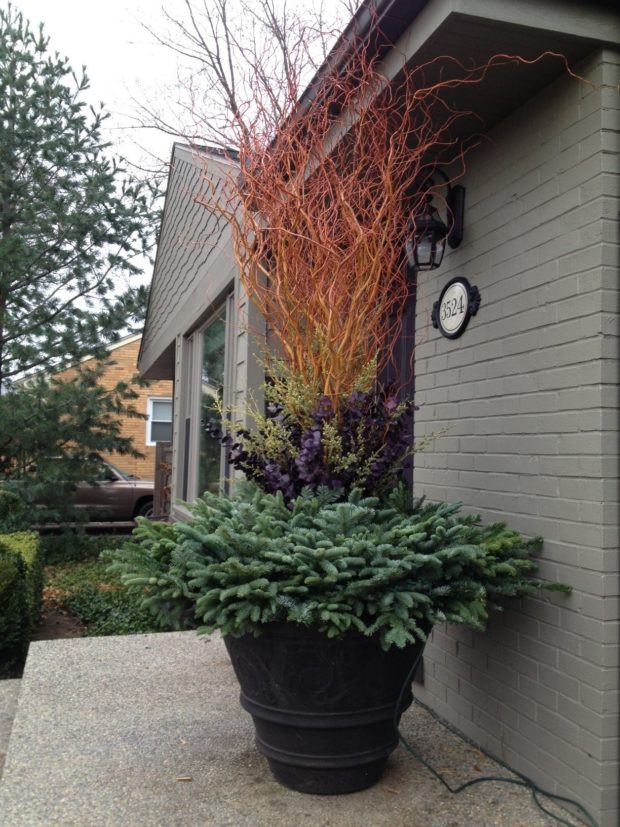 One pot on the porch for winter-it is enough. The arrangement is as wide as it is tall. A winter container featuring curly copper willow is showy.
One pot on the porch for winter-it is enough. The arrangement is as wide as it is tall. A winter container featuring curly copper willow is showy.
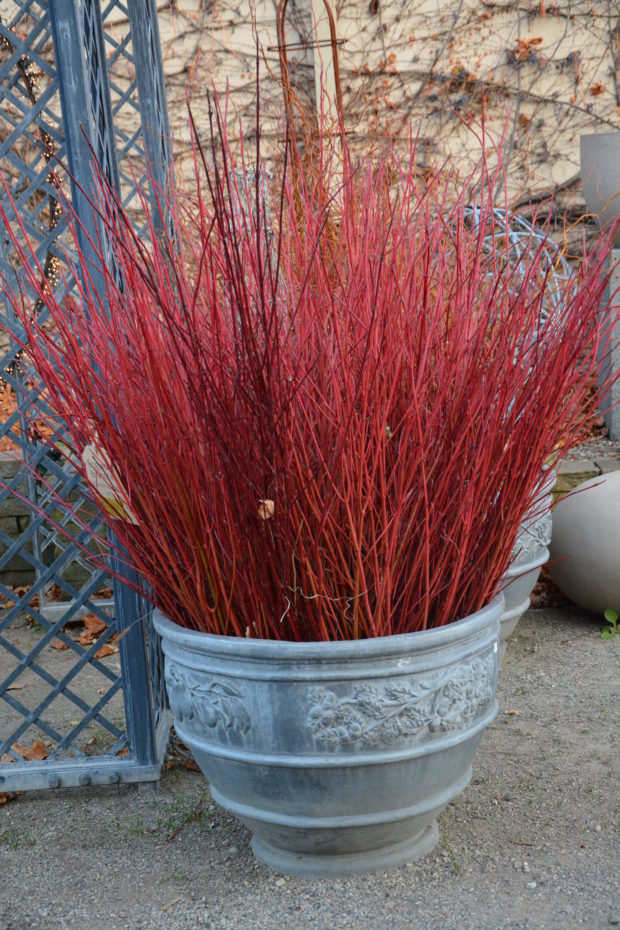 Red twig dogwood is a shrub common in my zone. It tolerates wet feet, and likes full sun. I do not have a spot big enough in my yard to grow red twig dogwood, but I am happy to have the cut branches available to place in winter containers. The hybrid red twig dogwood known as “Cardinal” features branches a much more brilliant red than the species.
Red twig dogwood is a shrub common in my zone. It tolerates wet feet, and likes full sun. I do not have a spot big enough in my yard to grow red twig dogwood, but I am happy to have the cut branches available to place in winter containers. The hybrid red twig dogwood known as “Cardinal” features branches a much more brilliant red than the species.
 This picture clearly illustrates the color of the hybrid Cardinal red twig, as opposed to the darker red of the species. No matter your taste in red, our twig supplier delivers well branched bunches of a uniform size. Red twig shrubs specifically grown for cut branches are regularly pruned, as the current year’s growth has the best color.
This picture clearly illustrates the color of the hybrid Cardinal red twig, as opposed to the darker red of the species. No matter your taste in red, our twig supplier delivers well branched bunches of a uniform size. Red twig shrubs specifically grown for cut branches are regularly pruned, as the current year’s growth has the best color.
 These gorgeous fresh growth red twig branches will become part of a series of holiday/winter container arrangements we will install next week.
These gorgeous fresh growth red twig branches will become part of a series of holiday/winter container arrangements we will install next week.
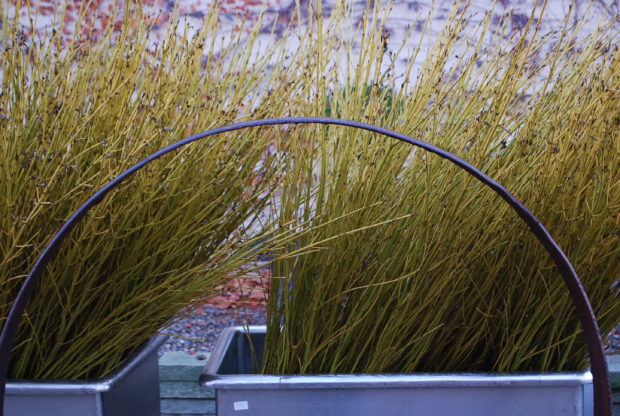 Yellow twig dogwood is of equally brilliant coloration. The bark is supple and glossy. Some stems verge on chartreuse. These stems can easily be incorporated into garlands, or woven into wreaths.
Yellow twig dogwood is of equally brilliant coloration. The bark is supple and glossy. Some stems verge on chartreuse. These stems can easily be incorporated into garlands, or woven into wreaths.
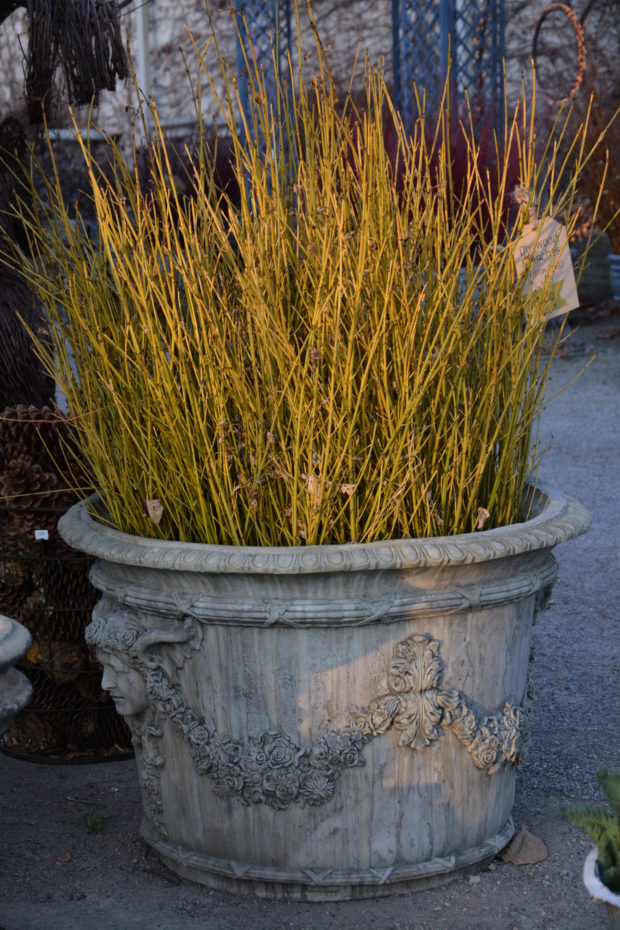 Yellow twig has a way all its own of picking up the light from the sun low in the winter sky.
Yellow twig has a way all its own of picking up the light from the sun low in the winter sky.
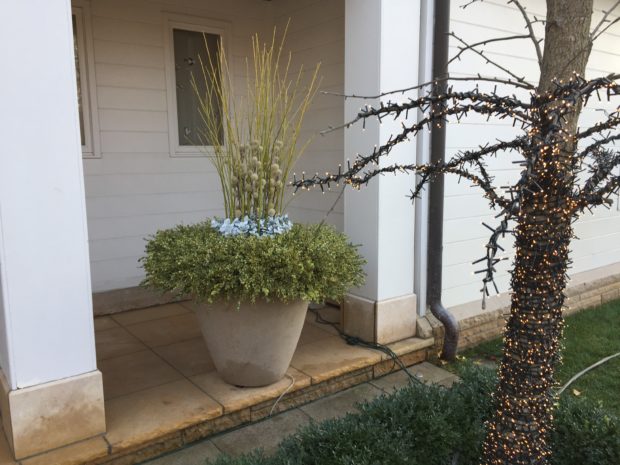 This contemporary winter arrangement featuring that yellow twig is accompanied by a group of pale yellow faux ball picks, and a generous skirt of variegated boxwood.
This contemporary winter arrangement featuring that yellow twig is accompanied by a group of pale yellow faux ball picks, and a generous skirt of variegated boxwood.
 That yellow twig does glow in the late and low afternoon sun.
That yellow twig does glow in the late and low afternoon sun.
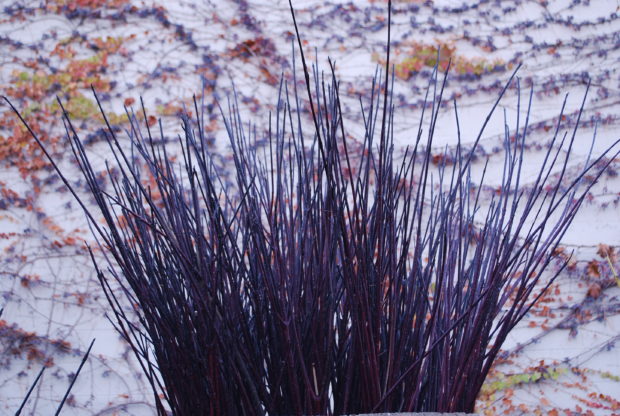 This black twig dogwood is reputed to be a very slow grower. It may be slow, but it is beautiful. My grower rarely produces over 100 bunches a year.
This black twig dogwood is reputed to be a very slow grower. It may be slow, but it is beautiful. My grower rarely produces over 100 bunches a year.
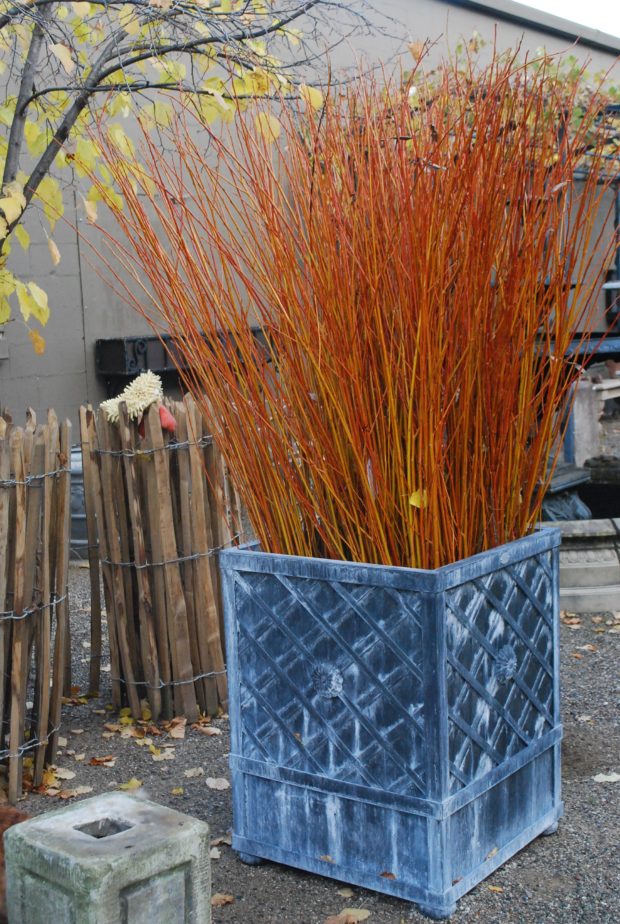 Flame willow is a strong growing shrub that grows very tall, and does not produce much in the way of horizontal branching. These tall vertical branches are a coppery cinnamon color. One bunch in a container is a statement. Multiple bunches in a container will make anyone stop and look. I always hope there will be flame willow still available when it is time to do my own pots.
Flame willow is a strong growing shrub that grows very tall, and does not produce much in the way of horizontal branching. These tall vertical branches are a coppery cinnamon color. One bunch in a container is a statement. Multiple bunches in a container will make anyone stop and look. I always hope there will be flame willow still available when it is time to do my own pots.
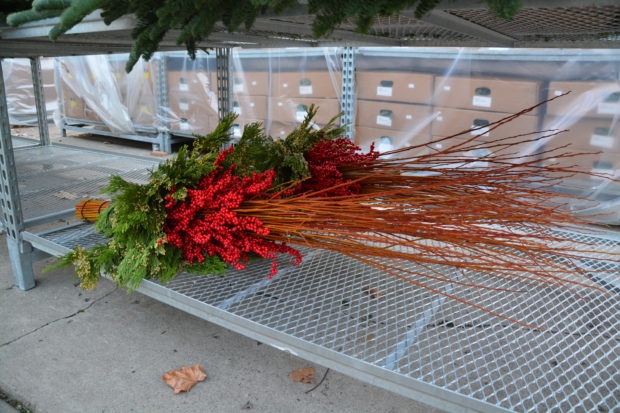 These winter container centerpieces featuring flame willow, faux red berry picks, and incense cedar are set to go in to a pair of winter pots we will install next week. The color is saturated and in dramatic contrast to the late November landscape.
These winter container centerpieces featuring flame willow, faux red berry picks, and incense cedar are set to go in to a pair of winter pots we will install next week. The color is saturated and in dramatic contrast to the late November landscape.
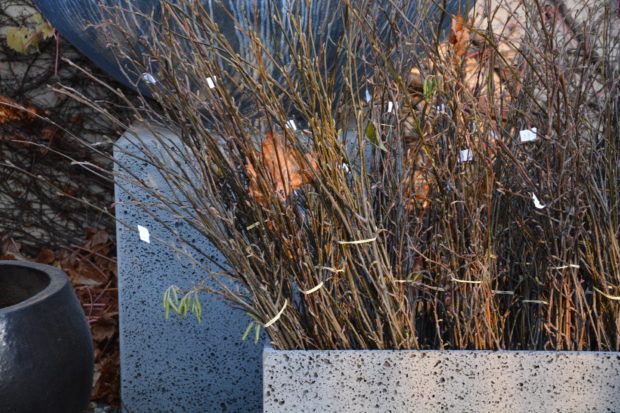 I usually have to remind Rob to buy me fresh cut alder branches. They are not showy in color or height. They are garden variety fresh cut twigs. There is plenty to like about a material that is ordinary as can be. They represent the winter garden in a more subdued way.
I usually have to remind Rob to buy me fresh cut alder branches. They are not showy in color or height. They are garden variety fresh cut twigs. There is plenty to like about a material that is ordinary as can be. They represent the winter garden in a more subdued way.
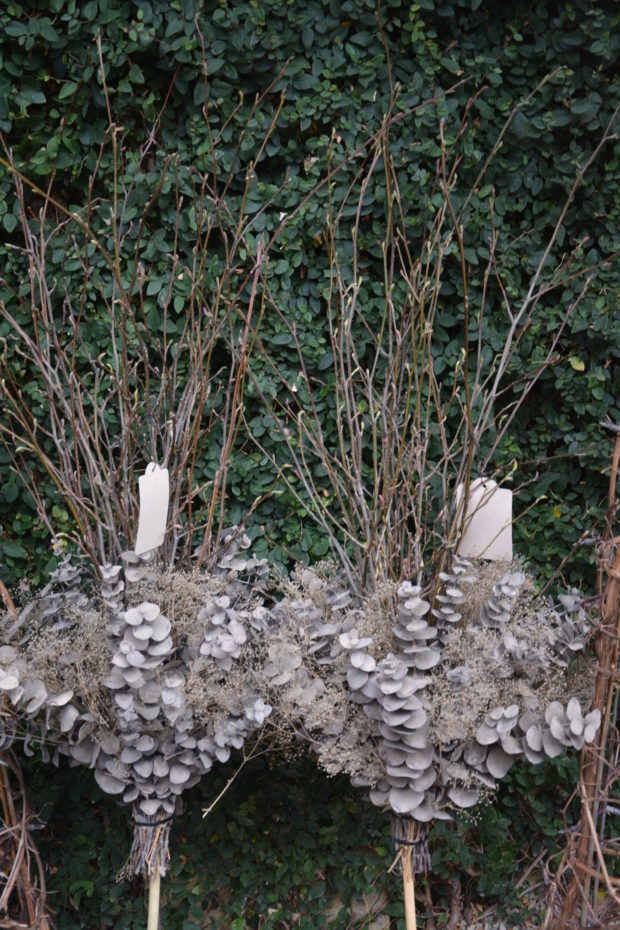 These container centerpieces featuring fresh cut alder branches, cafe eucalyptus and preserved gypsophila will eventually grace a pair of winter pots. The look is quiet, subtle, and wintry.
These container centerpieces featuring fresh cut alder branches, cafe eucalyptus and preserved gypsophila will eventually grace a pair of winter pots. The look is quiet, subtle, and wintry.
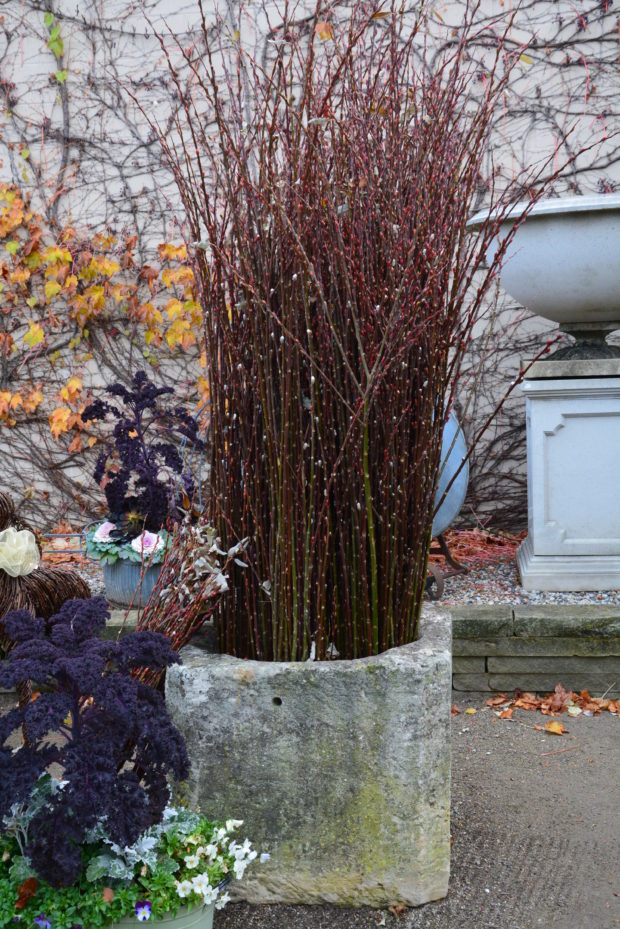 The red twig pussy willow from our grower is spectacular. The bunches are better than 5 feet tall. The medium bunches come in at 4 feet tall. The red, green and brown coloration is so easy to to appreciate, and work with.
The red twig pussy willow from our grower is spectacular. The bunches are better than 5 feet tall. The medium bunches come in at 4 feet tall. The red, green and brown coloration is so easy to to appreciate, and work with.
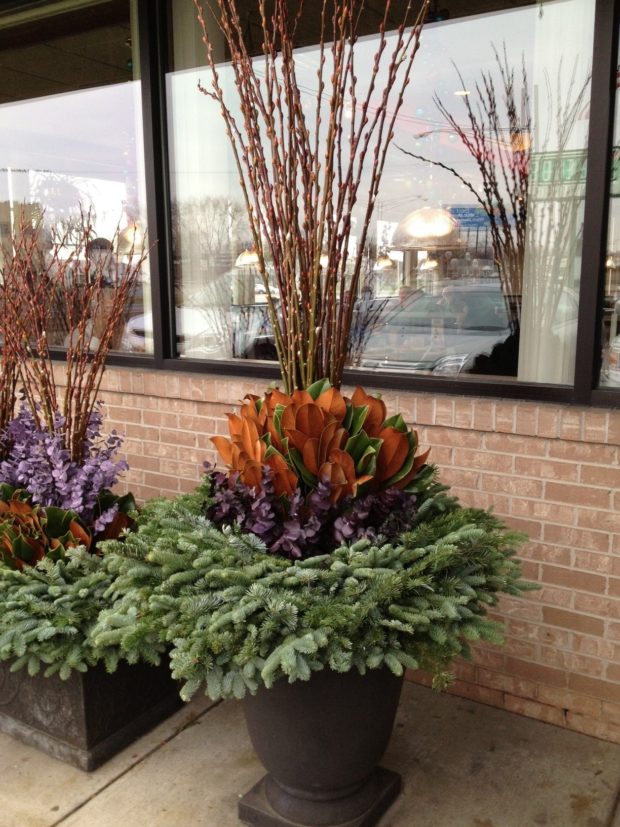 red twig pussy willow branches for winter
red twig pussy willow branches for winter
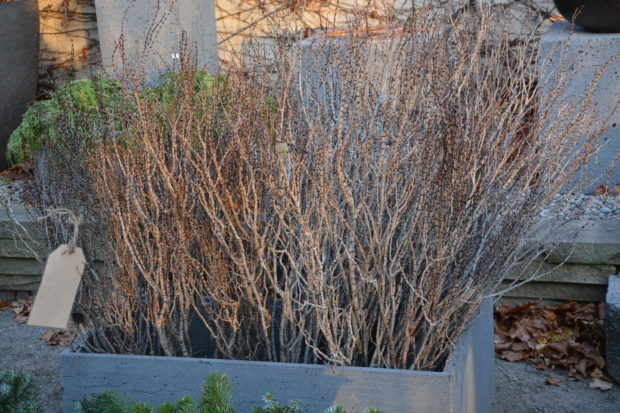 These tiger branches are new to us. They are harvested from a desert plant noted for its silvery gray bark, segmented by black horizontal bands. They are stunning indeed. Our clients think so too – we just got in our third shipment. I like to have a wide range of branches available. Beautiful natural materials are an invitation to participate in a little winter gardening.
These tiger branches are new to us. They are harvested from a desert plant noted for its silvery gray bark, segmented by black horizontal bands. They are stunning indeed. Our clients think so too – we just got in our third shipment. I like to have a wide range of branches available. Beautiful natural materials are an invitation to participate in a little winter gardening.
Beautiful!! Thank you Deborah for another inspiring post!
Hi. Could you give the Latin names for these various t
“twigs”/stems please? American common names differ from those elsewhere. I assume “twisted copper willow” is a kind of Avelana contorta, but what is the rest of the name (is it rufus or cuprus or??). Thanks.
Dear Jude, avellana contorta is a variety from the genus corylus, or common hazel. The genus for willow is salix. This should help you to be able to research the Latin names. best, Deborah
OK…my mistake about avelena and salix. Thanks for putting me right. But I have been trying for several days to find anything on the Web explaining what the Latin name is for “twisted/curly copper willow” – a description found on US sites, but nowhere for Europe. I cannot find the name and I thought you must know the Latin name, as you work with this material and are an “expert”.
Dear Jude, your mistake is substituting corylus for salix. “avellana” is a descriptive term for a particular type/variety of corylus. Botanical nomenclature would be the same for a species or cultivar no matter the country or continent where it is from or grown. It is the means by which people can communicate accurately about specific plants. The copper curly willow would be known as salix matsudama “Scarlet Curls” in the US and Europe, and everywhere else. best, Deborah
My favorite containers are always the ones with magnolia leaves and evergreen branches. Here in Minnesota, all my neighbors update their containers for winter by filling them with evergreens, interesting twigs, pine cones and berries. Thanks for sharing your amazing ideas!
What is the foam that you are putting the greens into? Is it a floral foam like Oasis, or a Styrofoam?
Dear Phillip, it is a dry floral foam. Styrofoam is too hard. Best, Deborah
I’ve followed your blog since I found it a little over a year ago. I was inspired to make some changes in my front garden area this past spring by pulling out some of the random grasses I’d planted over the years. I planted 4 arctic fire red twig dogwood shrubs which are supposed to be a smaller version of the traditional red twig dogwood (time always tells in the garden). Red branches poking through the snow this winter will be quite pretty I think.
Lovely and inspiring! Can’t wait to visit DGW to pick some of my own!!
Your colorful twigs are an inspiration, not only for pots but for growing in the garden, including some swampy parts. Thanks Deborah, once again, for your beautiful ideas.
Deborah, Could you talk about how to add string lights to winter containers? I’d like to know at what stage you start adding the lights, do you weave them in and out of the greens, do you wrap them to the outside of the greens, etc. Thank you.
Dear Nancy, how to do the lights depends on what effect you want. Sometimes I wrap them around the centerpiece, just to light that part of the container. If I want light all over, I tuck them into the greens so the cords are not so noticeable. It helps to have them plugged in when you are working with them. I do the lighting at the very end of the construction. all the best, Deborah
Hi Deborah,
I live in Fairview, NC, the western part of NC, in a development with no street lights. I would like the two containers on my front porch to be well lite. What length string lights do you find the easiest to work with? At what point do you start weaving the lights through the greens?
Dear Nancy, The length of the string depends on the type of lights you are using. I start on the outside edge of the greens, so the plug is at the bottom. I would just keep adding lights until you think you have a little too many! all the best, Deborah
Thank you Deborah! Do you spray your evergreens or any of your winter pot plantings with a preserving type of product? I have heard of the product stop-wilt. Just wondering. Wishing you a blessed Thanksgiving. I give thanks for being able to read your blog and view all of your inspiring pictures.
Hi Deborah! I love all the ideas for doing winter pots and last weeks post with the lights! However I live in Utah and can not come in to your shop. Earlier this fall I tried some other ideas with cut stems of pyracantha in fall pots. They looked great but wilted quickly. Do you use a preservative on the leaves of the boxwood, etc?
Keep writing! Thanks!
Sharon
OH! JUST! WOW!
There are no sources in or near my little town for anything like your exotic branches.
I do manage to forage some red dogwood, snowberry, oregon grape and abundant evergreens.
I’ve taken to wrapping containers with plaid wool scarves from the thrift store for more
colour and might get out the spray paint.
Your designs are exquisite and I am inspired to be more creative with what I
do have.
Thanks so very much for your wonderful blog.
Deborah,
Do you happen to know what the actual name of the tiger branches is?
Dear Chris, I do not, but I am sure if you poke around on a computer long enough you will find the name. best, DFeborah
Deborah, I asked you earlier in the year about getting some black twig dowgwood branches and the pricing of them. Do you have that available? Also shopping to sandy, utah 84092. Thanks
Dear Christopher, we will have the black dogwood bunches in mid November. Contact sunne@detroitgardenworks.com, and ask her to email you when it is available. We won’t be able to quote shipping until we have them. thanks, Deborah